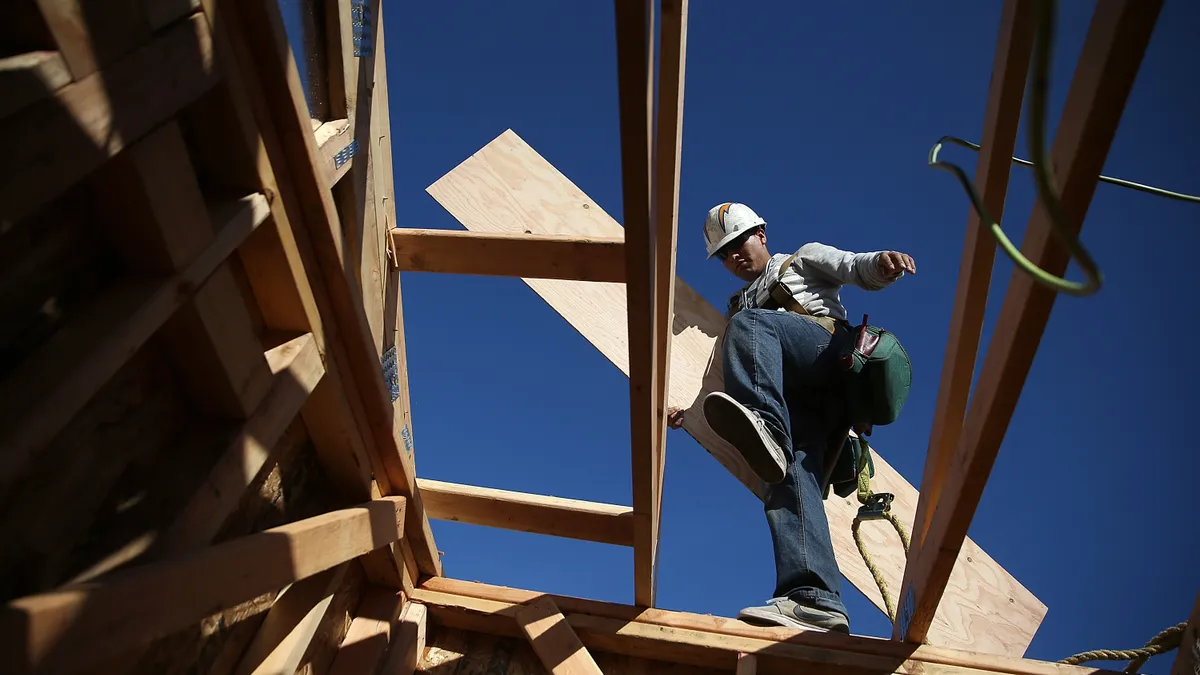Dive Brief:
- The amount of future work in the pipeline for U.S. commercial contractors fell slightly last month, even as proposals for new projects remained strong.
- Associated Builders and Contractors' Construction Backlog Indicator declined to 7.6 months in September. While it decreased 0.1 months from August, it was up 0.1 months from September 2020.
- In addition, ABC's Construction Confidence Index readings for sales, profit margins and staffing levels also declined in September, but remain above 50, indicating growth expectations over the next six months.
Dive Insight:
The falloff in ABC's recent Construction Backlog Indicator stands in contrast to the optimism expressed earlier this year as the pandemic was showing signs of receding. Despite the challenges, in The Marcum National Construction Survey, released last week, construction executives generally expressed optimism for the future.
Fifty-four percent of respondents said they anticipate more opportunities in their regions in the next three years and 43% expected more opportunities outside their regions. Twenty-nine percent of Marcum's respondents said their backlogs would be higher at the beginning of 2021 than in the same period of 2020. Thirty-two percent of respondents said the average size job they bid on in the prior 12 months had increased.
But the backlog issues, caused by skills and input shortages of materials such as copper and PVC pipes, could stifle that strong demand. With lingering supply chain issues, input prices continue to rise, according to ABC Chief Economist Anirban Basu.
"Rising shipping and trucking costs are further exacerbating the situation by placing additional upward pressure on input prices," Basu said in a statement. "Working in conjunction with skills shortages and attendant higher wages, rising input prices are resulting in lofty bids, inducing certain project owners to delay work and even cancel projects altogether in some instances."
The Marcum National Construction Survey also noted issues with finding workers, though the level of concern dropped from 34% of respondents in 2020 to 26% in 2021.
"Labor and material costs are the blocking and tackling of the construction industry," Joseph Natarelli, national leader of Marcum's Construction Services practice and office managing partner in New Haven, Connecticut, said in a statement. "The industry faces challenges with both as material prices spike and labor shortages remain. Finding skilled labor, managing price volatility, and mitigating the risks that come with rising costs are top priorities for many respondents."
More proposal activity
If proposals, which represent one of the earliest stages of the project lifecycle, are any indication, demand should remain strong for new projects, according to David Burstein, senior principal at AEC advisory services firm PSMJ Resources.
The overall proposal opportunity Net Plus/Minus Index (NPMI) for architecture, engineering and construction slipped to 38% from a record-setting level of 52% in the second quarter, according to PSMJ. The index rose for only two (environmental and energy/utilities) of the 12 major markets. Still, it was the strongest third quarter in the 18-year history of PSMJ's Quarterly Market Forecast (QMF), which represented a strong recovery after cratering to the lowest level in a decade in July 2020.
In the third quarter, the environmental market led the way with an overall NPMI of 63%. Housing (NPMI of 61%), Energy/Utilities (60%), Water/Wastewater (57%) and Healthcare (55%) were next. Commercial markets, with developers at 25% and users at 29%, lost ground in proposal activity.
With interest rates at low levels and high levels of liquidity in the market, it seems there is plenty of dry powder for real estate and construction projects if the numbers pencil out in the face of rising costs. Contractors collectively expect sales, staffing and profit margins to expand over the next six months as demand for construction services remains strong, according to Basu.
"Many projects, whether those in health care, public education or data management, must move forward, and the data indicate that this is disproportionately benefiting larger contractors," Basu said. "For the most part, recent declines in backlog have been registered among smaller construction firms."















